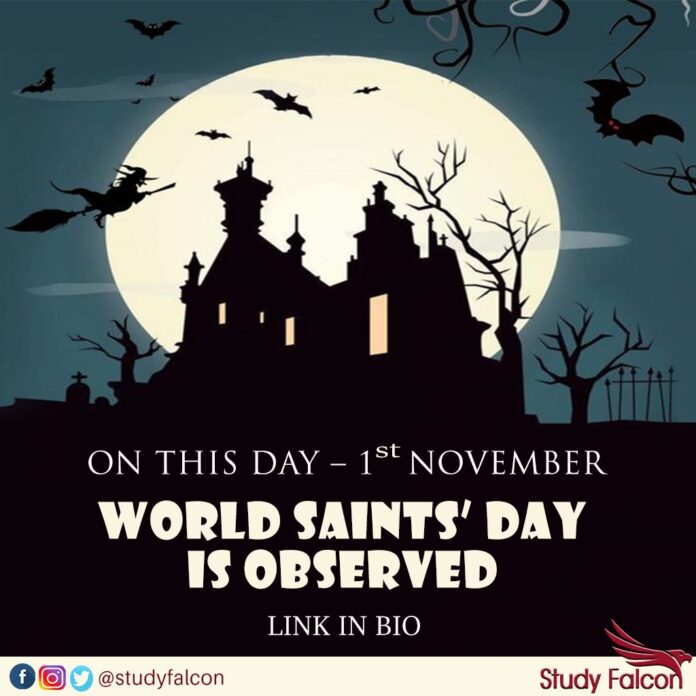All Saints’ Day, also called All Hallows’ Day, Hallowmas, or Feast of All Saints, in the Christian church, a day commemorating all the saints of the church, both known and unknown, who have attained heaven. It is celebrated on November 1 in the Western churches and on the first Sunday after Pentecost in the Eastern churches. In Roman Catholicism, the feast is usually a holy day of obligation.
All Saints’ Day is a celebration of all Christian saints, particularly those who have no special feast days of their own, in many Roman Catholic, Anglican and Protestant churches In Western Christianity, it is observed on November 1st by the Roman Catholic Church, the Methodist Church, the Lutheran Church, and other Protestant denominations. The Eastern Orthodox Church and associated Eastern Catholic churches observe All Saints Day on the first Sunday following Pentecost.
The Christian festival of All Saints Day comes from a conviction that there is a spiritual connection between those in Heaven and on Earth. In Catholic tradition, the holiday honors all those who have passed on to the Kingdom of Heaven. It is a national holiday in numerous historically Catholic countries. In Methodist tradition, All Saints Day relates to giving God earnest gratitude for the lives and deaths of his saints, remembering those who were well-known and not. Additionally, individuals throughout Christian history are celebrated, such as Peter the Apostle and Charles Wesley, as well as people who have personally guided one to faith in Jesus, such as one’s relative or friend.
The origin of All Saints’ Day may date back to a Greek Christian tradition from the 4th century, when a festival was held to honor saints and martyrs on the Sunday following Pentecost. Although now observed in November, All Saints Day was originally celebrated on May 13, and the origin cannot be traced with certainty. Pope Boniface IV formally started what would later be known as All Saints Day on May 13 in 609 AD when he dedicated the Pantheon in Rome as a church in honor of the Virgin Mary and all martyrs.
In France church services in memory of all the saints are held on November 1 but by the evening the focus turns towards the dead. Cemeteries everywhere are crowded with people who come to clean and decorate family graves. All Saints’ Day is closely tied with All Souls’ Day, held on November 2, which is dedicated to prayers of the dead who are not yet glorified.
In 835 CE, during the reign of Pope Gregory III, the festival was moved to 1st November and was expanded to include the honouring of all saints. It is likely that 1st November was intentionally chosen to replace the pagan feast of the dead, Samhain. The night before Samhain was a time when evil spirits roamed the land looking for humans. To confuse the spirits, people would dress up as creatures. This tradition carried on after 1 November became a Christian festival, hence the name of Halloween – which is a shortened version of All Hallows’ Eve.
While many canonized saints are celebrated with their own individual day (such as St. Patrick), saints that have not been canonized have no particular holiday. All Saints Day recognizes those whose have attained heaven, but their sainthood is known only to God. Even so, Catholic observances tend to focus on known saints, those canonized by the Catholic Church.
In Roman Catholicism, All Saints’ Day is a Holy Day of Obligation. This means Catholics must go to Mass on the date unless there is a good reason not to attend, such as illness. The holiday is typically observed with a reading of the Beatitudes, eight blessings given in Jesus’ Sermon on the Mount as recounted in the Gospel of Matthew. The day was abolished as a church festival in 1770, but may be celebrated by many churches on the first Sunday in November. The day survived the Reformation, though the Protestants combined it with All Souls’ Day, which was on 2nd November.
In addition to weekly worship gatherings, “All Saints Day” annually reminds of connectedness as Christians. It’s commemorated every November 1st. God calls a “saint” anyone who trusts in Christ alone for salvation.
There’s a hymn that’s traditionally sung around this holiday called “For All the Saints.” It encourages believers to look back through the years of Christian history and think of the millions now enjoying rest and salvation in the presence of God. It’s also meant to provide encouragement to believers here and now to press on, looking forward to the glorious day.










